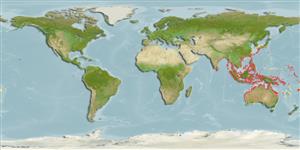>
Gobiiformes (Gobies) >
Gobiidae (Gobies) > Gobiinae
Etymology: Cryptocentrus: Greek, kryptos = hidden + Greek, kentron = sting (Ref. 45335).
Environment: milieu / climate zone / depth range / distribution range
Écologie
marin benthopélagique; profondeur 1 - 10 m (Ref. 90102). Tropical
East indian Ocean to Western Pacific: Andaman Sea to Papua New Guinea and Palau; north to Yaeyama Islands and throughout the East Indian region.
Taille / Poids / Âge
Maturity: Lm ? range ? - ? cm
Max length : 10.0 cm TL mâle / non sexé; (Ref. 90102)
Description synthétique
Clés d'identification | Morphologie | Morphométrie
Épines dorsales (Total) : 7; Rayons mous dorsaux (Total) : 10; Épines anales: 1; Rayons mous anaux: 9. This species is characterized by the following: D VI + !,10; A I,9; pectoral fin-rays 16-18; pelvic fin united , frenum present; longitudinal scales 75-82; head no scales; greatest body depth 4.1-5.2 in SL; caudal fin rounded, longer than head length; variable coloration ranging from yellow to mainly dark brown; diffuse bars on side; a pair of large, distinct dark-brown streaks above rear corner of the mouth and a second pair on gill cover; blue streaks on pelvic, anal and caudal fins. The yellow or yellowish brown variety has the same head markings (usually fainter), blue spots on the head, pale saddles across top of head and back; blue streaks on yellow pelvic and anal fins. The dark variety have similar head markings to pale and yellow varieties, but mainly dark brown body with several pale saddles across the back. All varieties have short bar across upper pectoral-fin base (Ref. 90102).
Inhabits sand-silt bottoms (Ref. 90102); associated with alpheid shrimps (Ref. 96641).
Life cycle and mating behavior
Maturities | Reproduction | Spawnings | Egg(s) | Fecundities | Larves
Allen, G.R. and M.V. Erdmann, 2012. Reef fishes of the East Indies. Perth, Australia: Universitiy of Hawai'i Press, Volumes I-III. Tropical Reef Research. (Ref. 90102)
Statut dans la liste rouge de l'IUCN (Ref. 130435)
Menace pour l'homme
Harmless
Utilisations par l'homme
Outils
Articles particuliers
Télécharger en XML
Sources Internet
Estimates based on models
Preferred temperature (Ref.
123201): 26.7 - 29.3, mean 28.7 °C (based on 1817 cells).
Phylogenetic diversity index (Ref.
82804): PD
50 = 0.5000 [Uniqueness, from 0.5 = low to 2.0 = high].
Bayesian length-weight: a=0.00708 (0.00333 - 0.01504), b=3.09 (2.92 - 3.26), in cm total length, based on LWR estimates for this (Sub)family-body shape (Ref.
93245).
Niveau trophique (Ref.
69278): 3.3 ±0.4 se; based on size and trophs of closest relatives
Résilience (Ref.
120179): Haut, temps minimum de doublement de population inférieur à 15 mois (Preliminary K or Fecundity.).
Fishing Vulnerability (Ref.
59153): Low vulnerability (10 of 100).
